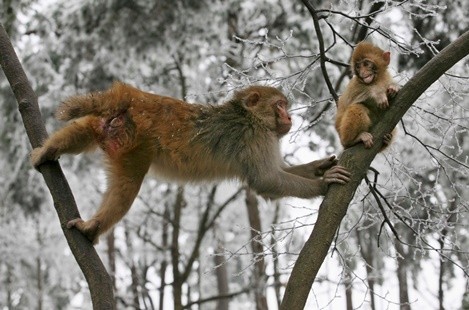A new species of macaque was discovered after Chinese experts found them in southeast Tibet’s Modog County, the Xinhua News Agency reported.
The discovery of the new monkey species, named the white-cheeked macaque, was published on the website of American Journal of Primatology last month.
Experts said the group of monkeys were already feeling the stress of human activities and encroachment of territory and urgently needs protection.
According to the report, it was Chinese wildlife photographer Li Cheng who first identified the new species after he heard them in the woods in 2012.
Li, however, recalled that the group of around 10 macaques vanished into the woods before he could even see them, the report added.
The report said that Li joined a field survey of wild species in Tibet in Oct. 2013, particularly in the primeval forest in Modog, where he set up 31 cameras with motion sensors to take photos and video. Half a year later, he had 738 photos and more than 100 videos of the macaques, which he called special.
Fan Pengfei, an associate professor of primate studies in Dali University, and Zhao Chao, a researcher at Southwest Forestry University, in Dec. 2014, also claimed to have seen the "special macaques" in Modog.
Li, Fan and Zhao were able to determine that the species appeared distinct from all known species of macaque through the photographs.
The report said that the new macaque's most distinguishing feature was the regular off-white fur on the cheeks of the adults. Their other distinctive marks included long, thick hair on the neck, a hairless short tail, dark skin on the muzzle, and round male genitalia.
The white-cheeked macaque's alarm call was high-pitched, different from the low-pitched call of southwest China macaques, according to a sonogram made by Peng.
Li estimated the population of the white-cheeked macaque at about 500.
"Due to ethical concerns about killing wild primates, we did not obtain a specimen, so our study was based on photographs and analysis of its physical attributes to determine it was a new morphospecies," Peng said.
"Currently, Modog is the only known habitat of the white-cheeked macaque, though its range may extend to neighboring counties in China and regions of southeast Tibet controlled by India," Li was quoted as saying.
Li Baoguo, president of the China Primatological Society, said that the discoveries of new species of mammals, especially primates, are rare.
"The white-cheeked macaque is the second new species of macaque recorded in the past century. This discovery is significant in the study of biodiversity changes caused by human activities."




























